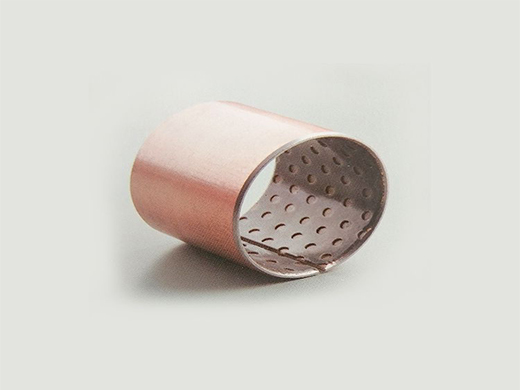
※ Metallographic analysis and material structure
1. Mixture of polyformaldehyde and lead 0.3-0.5mm
2. Spherical bronze powder 0.2-0.3mm
3. Steel backing 0.4-2.2mm
4. Galvanized coating:the thickness of copper coating is 0.008 mm
SF-2X boundary lubricating bearing is based on the steel plate in which the spherical bronze powder is sintered in the middle and the modified POM is rolled on the surface. Also, the oil pocket is included. It is applicable to the low speed and high&am
1. It features good load bearing and wear-resisting property.
2. It is applicable to the rotational motion and oscillating motion under high load and low speed as well as the condition in which start and stop with loading are frequent, also, it is hard to form the hydrodynamic lubrication.
3. Under the boundary lubrication, it could be free from lubricating and maintenance for a long time. Also, lubricating through the layer could extend the service life of the bearing.
4. As for machine shaping, certain margin could be available for the plastic layer of the surface, which could be under self-processing after installed and pressed into the seat hole, to achieve the better fixing dimension.
5. The product is mainly used in the motorcar chassis, metallurgical machinery, mining machinery, water conservancy machinery, construction machinery, agricultural machinery and rolling equipment.
Wear and tear a law of SF-2
The SF-2 material has its special wear rule. As shown in Figure 4, it can wear very little in R stage when it is coated with grease during installation. After the R stage time, the boundary oil lubrication condition is lost, and the wear begins to intensify. If refuelling is carried out at this time, no significant wear can be maintained and the service life can be greatly prolonged. Therefore, the advantage of SF-2 material is that it needs to be refueled once in the R phase of interphase melting, and its interval R is significantly longer than that of other materials, especially metal materials. About five times.
When lubricating grease (such as lithium grease or silicon grease) is applied during assembly, the service life of SF-2 bushing goes up and down with the PV value during operation. For example, when the PV value is about 2.5mpam/s, the service life is about 200H. When the PV value is about 0.1mpa-m / s, the service life of SF-2 bushing can be more than 10000 hours (see table for details). The service life of SF-2 bushing in the same period R is about half of the service life. For example, when PV = 2.5mpam/s, oil must be added for maintenance every 100 hours.
Wear and tear a law of SF-2
The SF-2 material has its special wear rule. As shown in Figure 4, it can wear very little in R stage when it is coated with grease during installation. After the R stage time, the boundary oil lubrication condition is lost, and the wear begins to intensify. If refuelling is carried out at this time, no significant wear can be maintained and the service life can be greatly prolonged. Therefore, the advantage of SF-2 material is that it needs to be refueled once in the R phase of interphase melting, and its interval R is significantly longer than that of other materials, especially metal materials. About five times.
When lubricating grease (such as lithium grease or silicon grease) is applied during assembly, the service life of SF-2 bushing goes up and down with the PV value during operation. For example, when the PV value is about 2.5mpam/s, the service life is about 200H. When the PV value is about 0.1mpa-m / s, the service life of SF-2 bushing can be more than 10000 hours (see table for details). The service life of SF-2 bushing in the same period R is about half of the service life. For example, when PV = 2.5mpam/s, oil must be added for maintenance every 100 hours.
Max. bearing pressure: 70N/mm2
Applicable temperature range:-40~+130°C
Highest sliding speed: 2.5m/s
Friction coefficient: 0.05~0.25
Allowable max. PV value : 2.8N/mm2.m/s
Allowable max. PV value : 22N/mm2.m/s